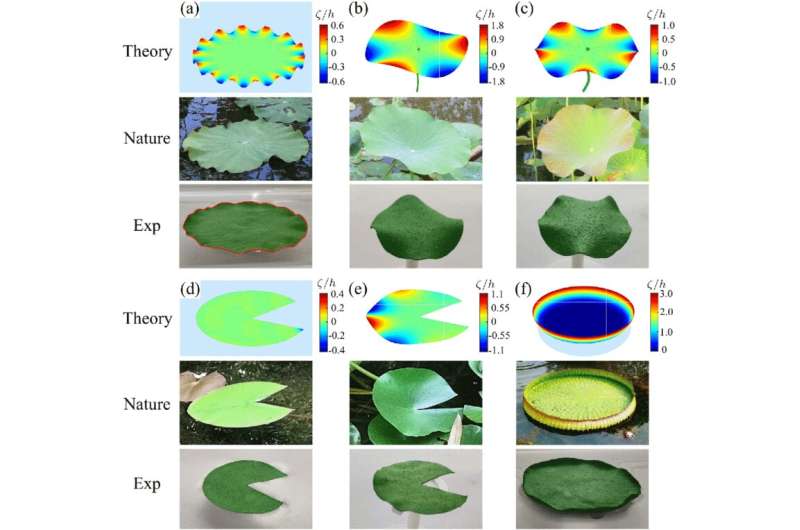January 29, 2020 report
Improved mathematical model helps explain different lotus leaf types

A trio of researchers at Fudan University has improved a mathematical model to allow it to predict the shape of different leaf types on lotus plants. In their paper published in the journal Physical Review Letters, the group describes their mathematical work and how they tested it with real world materials.
Back in 2008, a team in France created a mathematical model to describe soft tissue growth as a means of predicting the ways in which algae and mushroom shapes arise. In this new effort, the researchers extended the earlier model to include leaf growth on plants.
The new model includes two new elements in growth predictions: leaves that are floating on water and layers of cells on leaves that grow at different rates, resulting in leaf bending. Notably, the researchers modified the earlier model to explain how lotus plants are able to produce two kinds of leaf patterns. Lotus leaves that float on the surface of the water are flat with frills around the edges. Leaves that grow above the water are bowl-shaped. By allowing for the two new elements, the researchers were able to accurately model and predict growth patterns for lotus leaves.
In both cases, the model took into account the impact of the wavy edges that occur when a leaf grows with more surface area than can fit on a smooth surface. With water-bound leaves, the energy required to lift adhering water is minimized by the flat configuration. The leaves that grow above the water are not pulled down by the weight of water—they are free to grow into any shape. But because cells grow faster where sunlight hits them, they form bowls that follow the sun like sunflowers. The steepness of the bowl walls fluctuates depending on environmental conditions.
The model was initially tested via computer simulations. It was then put to a real-world test by using a material stand-in for lotus leaves that was much easier to test. The material they chose grows when water is applied. That allowed the researchers to see how the material would take shape when floating on water versus when it was suspended above it. The test showed the leaves forming in the same shapes as lotus plants.

More information: Fan Xu et al. Water Affects Morphogenesis of Growing Aquatic Plant Leaves, Physical Review Letters (2020). DOI: 10.1103/PhysRevLett.124.038003
Journal information: Physical Review Letters
© 2020 Science X Network



















